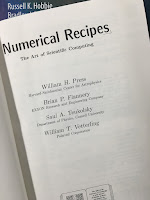 |
| Numerical Recipes, by Press, Teukolsky, Vetterling, and Flannery. |
The address of the Numerical Recipes website is easy to remember: numerical.recipes. There you will find free copies of the second editions of Numerical Recipes for Fortran 77, Fortran 90, C, and C++ (2002). If you want easy, quick access to the third edition (2007), you will have to pay a fee. But if you are willing to put up with brief delays and annoying messages (which the authors call “nags”), you also can read the third edition for free.
The text below is from the Preface to the third edition.
“I was just going to say, when I was interrupted...” begins Oliver Wendell Holmes in the second series of his famous essays, The Autocrat of the Breakfast Table. The interruption referred to was a gap of 25 years. In our case, as the autocrats of Numerical Recipes, the gap between our second and third editions has been “only” 15 years. Scientific computing has changed enormously in that time.Russ and I cited Numerical Recipes in IPMB when we discussed integration, least squares fitting, random number generators, partial differential equations, the fast Fourier transform, aliasing, the correlation function, the power spectral density, and bilinear interpolation. Over the years, in my own research I have consulted the book about other topics, including solving systems of linear equations, evaluation of special functions, and computational analysis of eigensystems.
The first edition of Numerical Recipes was roughly coincident with the first commercial success of the personal computer. The second edition came at about the time that the Internet, as we know it today, was created. Now, as we launch the third edition, the practice of science and engineering, and thus scientific computing, has been profoundly altered by the mature Internet and Web. It is no longer difficult to find somebody’s algorithm, and usually free code, for almost any conceivable scientific application. The critical questions have instead become, “How does it work?” and “Is it any good?” Correspondingly, the second edition of Numerical Recipes has come to be valued more and more for its text explanations, concise mathematical derivations, critical judgments, and advice, and less for its code implementations per se.
Recognizing the change, we have expanded and improved the text in many places in this edition and added many completely new sections. We seriously considered leaving the code out entirely, or making it available only on the Web. However, in the end, we decided that without code, it wouldn’t be Numerical Recipes. That is, without code you, the reader, could never know whether our advice was in fact honest, implementable, and practical. Many discussions of algorithms in the literature and on the Web omit crucial details that can only be uncovered by actually coding (our job) or reading compilable code (your job). Also, we needed actual code to teach and illustrate the large number of lessons about object-oriented programming that are implicit and explicit in this edition.
I highly recommend Numerical Recipes to anyone doing numerical computing. I found the book to be indispensable.



No comments:
Post a Comment